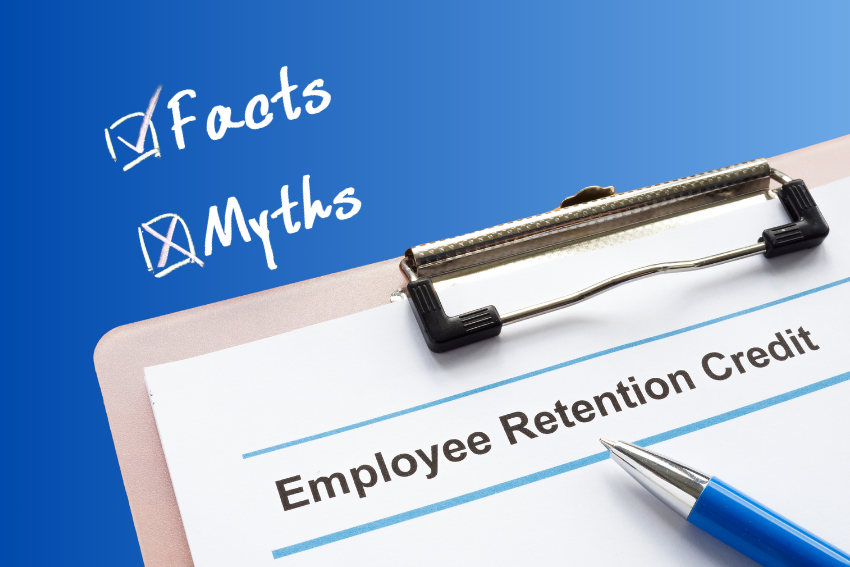If there is one payroll topic that has recently gained a lot of attention it is the Employee Retention Credit (ERC). The ERC is an employer credit that works as a refundable tax credit for employers stricken by the COVID-19 outbreak. Its goal is to stimulate companies to retain their employees on the payroll in difficult times while supporting them financially. But even now people continue to use the ERC improperly and there is a lack of understanding of this formula.

There are many myths floating about the Employee Retention Credit and, in this article, we will discuss ten of them and the fact about each of them to help those businesses that try to apply for the Employee Retention Credit to do it correctly.
Common Misconceptions About Employee Retention Credit
The ERC provides the chance to stay workers on the payroll and get funding, there are lots of myths about the program. This article is written with the intention of reducing those myths and giving more facts about the ERC to aid organizations to make the right choices.
Myth 1: The ERC is for purely shutdown companies as a result of the COVID-19 threat.
Fact: It is wrong to think that the ERC is for businesses that completely closed down as a result of the COVID-19 effects only. The truth of the matter is that even relatively ‘open’ businesses are able to apply to the ERC. For purposes of getting the credit, the trades or businesses must have suffered a reduction in the gross receipts or have been partially or fully shut down due to Covid – 19 related orders from the government. However, it implies that even businesses that were able to remain open during the pandemic qualify for the ERC.
Myth 2: The ERC program is only available to businesses for a given period.
Fact: Another myth associated with the ERC includes is that businesses can only claim ERC for a certain period, say 2020 or 2021. In fact, the ERC claimed period is Q1-Q3, 2021 and Q2, 2020. What this means is that businesses are able to retain the credit for 2021 if they manage to meet the relevant criteria.
Myth 3: The ERC is only available for small business.
Fact: The ERC is open to all sizes of businesses undergoing a partial or full plant shutdown due to operational changes. Perhaps this myth stemmed from the belief that small businesses were the hardest hit by the pandemic and, thus, the ERC’s target audience. Still, big businesses can also claim the ERC so long they meet the qualification criteria for instance a decline in the gross receipts of the business or operations of the business that have been halted by government orders.
Myth 4: The ERC can be claimed only if the business did not get the PPP loan.
Fact: This is another common misconception of the ERC. It is crucial to understand that businesses that got a PPP loan are not allowed to claim the Employee Retention Tax Credit for those same wages but they are not locked out entirely. For example, a business may have received a PPP loan but failed to use the money for the same wages or, at the time of applying for the loan forgiveness, may have claimed only a certain portion of wages they wanted to use this loan for; such an establishment may still be eligible for the ERC.
Myth 5: Any wages paid during the qualified period can be claimed under the ERC.
Fact: Although the ERC can help companies save a lot of money it is not refundable for all the wages paid within the eligible period. Based on these criteria, businesses needed to determine their eligible wages such as number of full- time employees in the business in 2019 and if it is a recovery startup business. Moreover, the amount of credit is limited by the maximum of specified percentage of the qualified wages depending on the quarter.
Myth 6: It is worthy of note that in order for the ERC to be granted, the business must have completely closed down.
Fact: It is wrong to state that the ERC relates to only those companies that have shut down their operations completely. An example of a situation where this kind of ‘reasoning’ will be regularly employed can be when companies and firms have faced partial lockdowns all thanks to government’s mandates. In such cases they may still be qualified for the ERC. For example, a government may have mandated that a business close, resulting in a drastic fall in gross receipts because the business was shut, even if it was still open for functions.
Myth 7: The ERC is only available for a certain type of business.
Fact: This is another very well-known myth in regard to the ERC regulation. It does not focus on a single sector, for instance, restaurants, hospitality, or retail business sectors. This credit is for companies in many fields which can satisfy the conditions for the ERC. This encompasses firms that report that gross receipts have been reduced by 50% or more or operations voluntarily or forcibly shut down due to COVID 19 restrictions by the government.
Myth 8: Employer cannot elect to claim the ERC for any period the employer paid employee leave during the coronavirus pandemic.
Fact: This is another imaginary notion people had about the ERC. Employers who offered paid time off to their workers while the pandemic was ongoing are not locked out from claiming the ERC. However, wages paid for paid leave should not be included in the computation for the qualified wages for the ERC. A portion of the payroll taxes paid on such wages includes employee payroll taxes that can be used as a credit against the amount of payroll taxes owed other than the ERC.
Myth 9: The ERC is only accessible to a company that has experienced a lesser revenue year as compared to the base year.
Fact: Although losing a substantial amount of revenue is enough for a business to be eligible for ERC, it is not the only factor. The other condition is that the business must have had some form of shutdown fully or partially due to government measures on COVID-19. This implies that besides the companies, which have seen their revenues reduced or closed down by government orders, can also benefit from the ERC if their operations were ceased regardless of any reduction in revenues.
Myth 10: The ERC is only available to entities that did not reduce the size of their workforce during the qualified period.
Fact: This is another myth about the ERC. Contrary to it, it is not mandatory for an employer to be precluded from eligibility for the program only because they do not retain his or her employees. It should also be noted that businesses can still claim ERC even if they have let go of employees, or let’s say if their operations have been fully or partially shut down because of the government orders, or they have experienced a gross receipt decline of 10 percent or more in any calendar quarter, relative to the same quarter in the prior year.
Conclusion
The Employee Retention Credit is one of the best options that businesses can utilize at the time of COVID-19 outbreak. It has been mentioned that the facts and the myths may influence the decision of companies in terms of ERC eligibility and its potential usage.
These companies have received assistance from the ERC to ensure they maintain their employees on payroll, and funds the ERC has supported them with. With the help of the ERC, companies can help their workforce and governments continue to stay afloat during the current pandemic.













+ There are no comments
Add yours